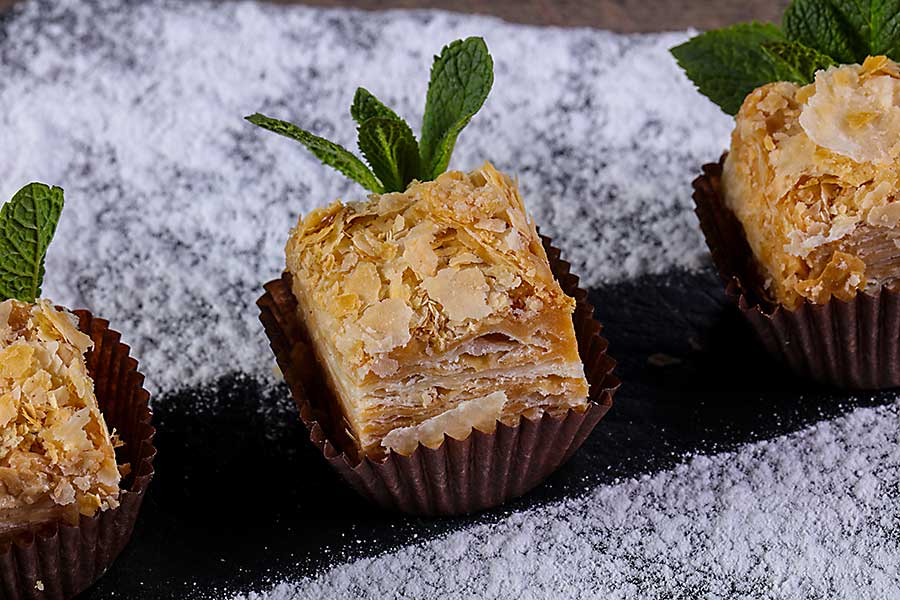Mille-feuille
Mille-feuille (pronounced meel-foy) is a type of French pastry that is otherwise known as vanilla or custard slice. It is made from layers of thin puff pastry that is alternated with a cream filling and topped with a ganache. The flavours of mille-feuille are relatively simple, but it is the textural elements that make the dessert difficult to master. A perfect mille-feuille will be equally airy, flakey, decadent, and crispy.
Mille-feuille is very similar to the Italian dessert, Napoleon. The main difference between the two desserts is that a Napoleon is layered with almond paste instead of cream. A traditional mille-feuille will consist of three layers of puff pastry alternated with two layers of pastry cream. Icing sugar will be dusted over the top, along with cocoa powder, pastry crumbs, and sometimes crushed nuts. Another version of mille-feuille is glazed with chocolate and vanilla icing or fondant. Other variations of mille-feuille are layered with whipped cream and fruit, and topped with custard.
The term mille-feuille is French for ‘one thousand petals’, referring to the decadent layering of pastry in the dessert. The mille-feuille is experiencing a resurrection, reappearing on menus in restaurants all over the world in both sweet and savoury forms.
The history of mille-feuille
The exact origin of mille-feuille is unknown. However the different elements (e.g. pastry and cream) can be traced back to cookbooks as far as the 16th century. The earliest known mention of the term mille-feuille is in an 18th century cookbook by French chef, Vincent La Chapelle. This recipe, however, refers to a pastry stuffed with marmalade instead of cream. Most early references to mille-feuille feature jam as a stuffing. The first recipe that does not is by Urbain Dubois in 1876, made with Bavarian cream instead. In the Oxford Companion to Food, Alan Davidson attributes the origin of mille-feuille to a type of Hungarian dessert called Szegediner Torte.
Different names and variations of mille-feuille
Mille-feuille has different names in different regions, as well as different variations in the recipes and ingredients.
- In Italy – Mille-feuille is called mille foglie and is not much different than the classic recipe. The main addition in Italian recipes is a layer of sponge cake as well as cream and puff pastry. Savoury variations exist that are stuffed with spinach, cheese, and pesto.
- In the UK – Mille-feuille is called vanilla, custard, or cream slice and commonly served with just two slices of pastry with a single layer of cream.
- In Canada – Mille-feuille is commonly referred to as gateaux Napoleon or Napoleon slice and stuffed with almond paste instead of cream. There is also a French Canadian variation where graham rackers replace puff pastry.
- In Australia & New Zealand – It is commonly referred to as a custard slice or vanilla slice. Many variations also include passionfruit flavoured icing instead of cream.
- In Sweden & Finland – Mille-feuille and Napoleon are combined in a dessert called Napoleonbakelse. This is stuffed with whipped cream, custard, and jam then glazed with icing and current jelly.
- Latin America – Mille-feuille is called milhojas and layered with dulce de leche. In Colombia, a version exists that is stuffed with dulce de leche and melted bocadillo (guava paste) and topped with whipped cream and coconut flakes.
Private Chefs, Art of Dining
CHEFIN is a private chef platform that’s reimagining social dining.
You can easily connect with 1 of our 250 private chefs and treat your guests to restaurant-quality dining experiences in the comfort of your own home, office or chosen venue. From high-end dining to quirky social food experiences, the CHEFIN platform makes it effortless for you to access gourmet food that’s worthy of a Michelin-starred establishment.
What you get:
-
- Your very own private chef who is vetted and insured,
- A customised menu for your needs,
- 24/7 concierge support,
- Complete post-dinner cleanup,
- A fun, stress-free, and unforgettably dining experience!


